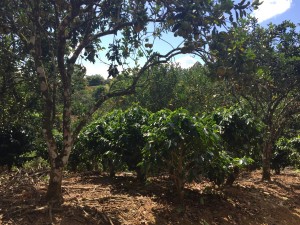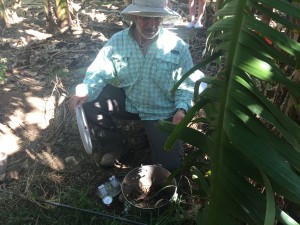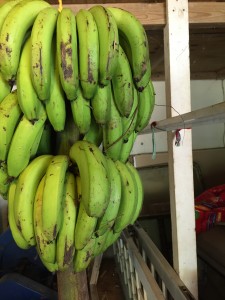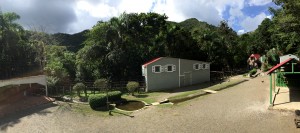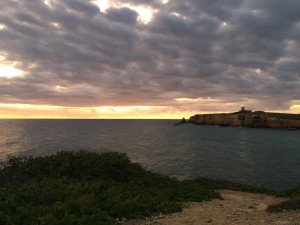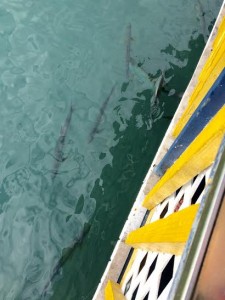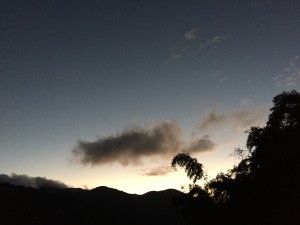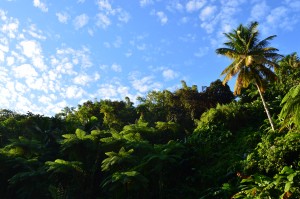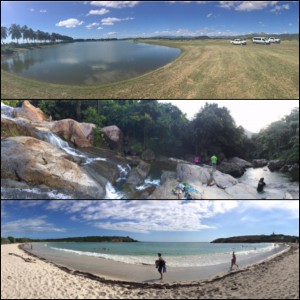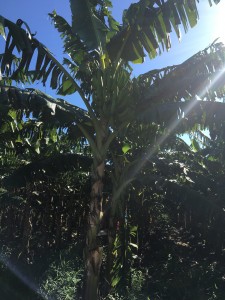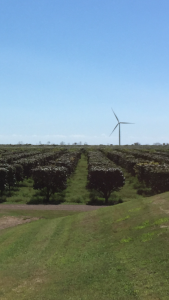
Trimmed mango trees at Martex
One located in the tropical south; one, in the temperate north. Rain forests and coral reefs cover and sur round one while prairies and woodlands spot the other. One, mountainous; the other…flat. One grows coffee and fruits; the other, corn and soybeans. Puerto Rico and Illinois, they seem vastly different with the vast distance between them, and in most respects, they are; however, the nature of the sustainable agriculture issues that they face—socially, economically, and environmentally—are the same.
I began to recognize the complexity of the issues facing Puerto Rico, especially in agriculture, when we visited Café Gran Batey, a small family coffee farm, but the social, political, and environmental context became more defined when we visited Martex, a larger scale fruit plantation. Since the business produces high quantities of products, greater challenges in terms the cost of employment and energy arise, so current economics and policy more intimately effect the profit and production of the plantation.
For example, the cost of energy remains very high in Puerto Rico because only a few businesses or the government own the energy sources, and the rest of the energy has to be imported. In order to curb energy costs, the plantation has made various installations of solar panels. However, the plantation only installed solar panels when there were government grant programs or other subsidies, so while solar panels provide clean, renewable energy, they were only installed when economically practical for the business. Thus, sustainability on a large scale requires not simply environmental viability with energy sources that do not pollute and can be continually renewed, but economic viability with businesses that maintain profits and provide people with the products that they need.
Further considerations arise for large scale production when managing pests and other plant diseases to ensure a quality product that consumers are willing to buy. Although pesticides are detrimental to the environment and potential cause unforeseen harms to both other species and the environment, they ensure that large losses do not occur because of certain fungi or insects, and they ensure that the costumer will be willing to buy the product. The owner provided me with one example when he discussed a specific insect that made little holes on plantain peels. The insects caused no harm to the edible part of the plantain, but consumers would not buy a plantain that appears damaged and unsafe to eat.
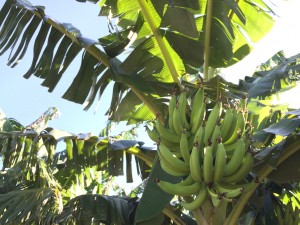
Plantains
Beyond pesticides, dominate concerns of the plantation are nutrient runoff, soil erosion, and greenhouse gas emissions. The University of Puerto Rico-Mayaguez is helping the farm specifically decrease emissions by carrying out experiments that test the quantity and quality of soil emissions when different methods of fertilization are used. An example of how methods of increasing production need to be balanced with environmental impacts, and in this case, how new technology and research can help farms find that balance.
The large scale plantation, with thousands of acres in production and that uses pesticides, contrasts directly with the ideal of the first small coffee farm that we visited, Hacienda Buena Vista, which promoted an organic method of farming that promoted incorporating farming into the rain forest ecosystem to conserve land and to protect biodiversity. Comparing and contrasting the farming methods certain questions come to mind. Can small production farms provide people with sufficient resources? What are the environmental impacts of a large scale plantation? Can a medium be reached between the two methods of agricultural production?
Illinoisans are asking the same questions. We too have small organic farms that wane in comparison to the enormous corn and soybean operations. Our large scale farms contribute significantly to nutrient pollution and emissions. The solutions lie in close research that can determine the farming methods that can minimize the environmental impacts while providing people with necessary resources and ensuring long-term economic stability for farming operations.
Wherever we go around the world, we will find agriculture and other industries in the same three circled sustainability Venn diagram, attempting to reach the center where people benefit, business grows, and the environment sustains itself. Coming to Puerto Rico, I more wholly understand the intimate relationship between the three themes of sustainability. If the environment is not protected in the long term, economic growth cannot be maintained. If the economy does not grow, the people suffer the consequences.
I’m excited to learn more and visit more places so that I can better understand how we can reach that equilibrium.


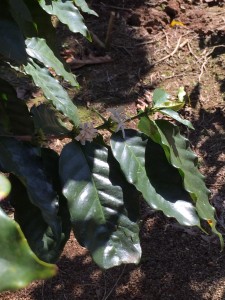 evere weather events occurring around the world, and I can detect that the seasonal variations are not quite the same, but I cannot truly understand the gravity of the effects of climate change until I hear about them first hand from those experiencing them and suffering their consequences.
evere weather events occurring around the world, and I can detect that the seasonal variations are not quite the same, but I cannot truly understand the gravity of the effects of climate change until I hear about them first hand from those experiencing them and suffering their consequences.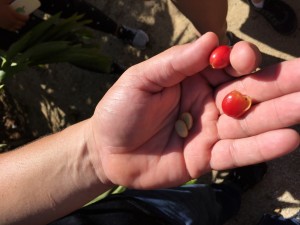 and food availability consequences for producers and consumers.
and food availability consequences for producers and consumers.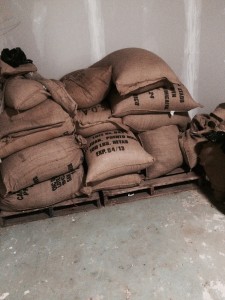 inable agriculture as well as their focus on education.
inable agriculture as well as their focus on education.